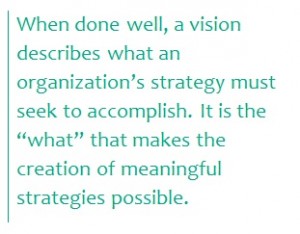What is a vision? Put simply it is an organization’s desired future state. Many leadership teams work hard to create a vision statement that works in concert with their organization’s mission statement. Often, however, this well-intentioned exercise results in an overly general statement that does not support creation of the strategy needed to achieve it. Consider the vision “A world without cancer.” It is surely ambitious and inspiring, but how does it inform strategy? While it clearly states a long-term goal or dream, it does not provide the context needed to create an actionable strategy.
To be useful in planning and to support action, a vision needs several characteristics:
• It should be time-bounded, describing the future at a defined time such as “five years from now” to provide a clear timeframe for action.
• It should be described in detail, helping those who need to accomplish it identify what must be done.
• It should tell a meaningful story that inspires those within an organization to align their actions toward its accomplishment.
When done well, a vision describes what an organization’s strategy must seek to accomplish. It is the “what” that makes the creation of meaningful strategies possible. Organizations that do the work to define specific details of the desired future state as a part of their vision can more clearly see and prioritize the things they need to do to achieve it.
Why do most visions fail to provide the detail and context needed to inform strategy? I think it comes down to human nature, particularly the nature of those of us leading organizations. We are action oriented, we want to get down to what we feel is the real work of business, solving problems and figuring out answers. Unfortunately, what is normally a highly desired management competency – being action oriented – sometimes creates a problem when planning. If we do not do the up-front work to set the target by defining the vision in detail, how do we know we are solving the right problems? More importantly, how do we know that the people who work for us, the ones that really solve the problems, will solve the right ones?
Take time, step back, consider carefully where your organization should go, and get help if you need it. If you create a vision that provides the detail and context for your organizations future, the strategies you develop will be more coherent and more focused on the results you seek.


